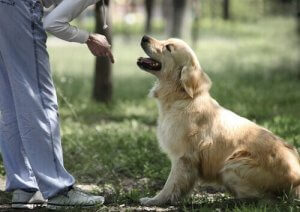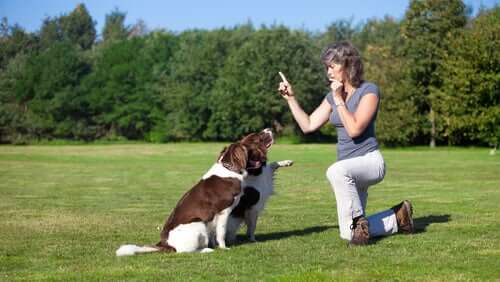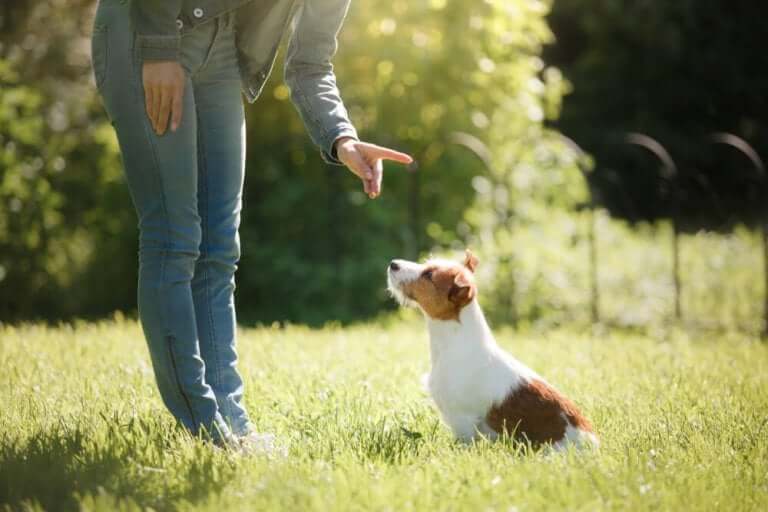Training Tips: How to Teach Your Dog to Sit

If you want to teach your dog to sit, and to stay seated, you need to go bit by bit. For a young, energetic dog or puppy, a first achievement might mean being able to sit still for just half a second.
Don’t worry, though, that’s fine. Once you’ve gotten to half a second, you can build up to one, then two, and so on. Doing it over a lot of short, successful sessions is a much better way to mold your dog’s obedience than doing one or two really long sessions. The dog will probably just end up doing it wrong, and leaving you frustrated.
How to teach your dog to sit
Training a dog to respond to the command “sit” is the first exercise you should try with it, and one of the most important it will ever learn.
- Start the training with a reward or a treat (treats are usually best). Make sure your dog knows you have it.
- Once your dog notices it, it will follow the treat with its head and try to get it.
- After that, hold the treat above its head so that it has to look up. Then move it back behind its nose, so that it has to move its head back. The only way for it to reach the treat will be to sit its rear end on the ground.
- The moment it sits, give it the treat and be very encouraging.
- After a few tries, your dog will know how to earn its treat, and it will start to sit more quickly.
Important things to keep in mind
Start with these simple steps in a place that’s familiar to your dog. It should also be free of distractions. You need to make sure your dog focuses on you when you’re in front of it. You also need to give it all your attention, and maintain eye contact with it.

If your dog stays sitting for a second or more, encourage it and give it a treat. Repeat that process but wait until it sits for a few seconds longer to give it the treat.
Once your dog is responding properly most of the time, add in the visual signal. Tell your dog to sit or lay down, then tell it to “stay.” As you do that, you should keep your hand (palm open) extended over its nose, in the “stop” position.
If it sits for a second, give it a treat. Repeat this whole thing over again, and start to increase the time with each new try, so that it will start to sit for longer.
Once it has a perfect understanding of what you want from it, start using the hand gesture you want it to learn. One good one is to have your hand out vertically in front of you, in the stop gesture. But the main thing is for everyone in your family to be consistent with the gesture.
Tell it to “sit” as it’s sitting down. That will help it associate the word with the action. Now that you’ve added the hand signal, you’ll be able to start practicing having it sit without needing to use a treat.
What to do if it’s not working
Once your dog stops sitting, tell it “sit” or “stay” or “down” (based on what position it was in originally). Once you’ve done that, try for a shorter sitting session.

If you’ve been practicing for a while and your dog knows the “stay” command, you can make your voice deeper to show it it’s not doing things right if it’s moving.
But don’t punish it, and never, ever hit it. The moment you get visibly annoyed with it, you’ve already put an end to the session. It will associate that with the act of sitting, and that will end up having the opposite results of what you’re going for.
How to teach your dog to sit for a long time
Once your dog has learned the “stay” command, you can start to make it more and more challenging. Move a foot away from your dog when you tell it to stay, then two feet, and on and on.
Tell it to stay with your back turned to it. Of course, start with no other people or dogs around. After it has started to learn, then you can practice with distractions in the area. An even higher level is to practice while you’re bouncing a ball. If your dog is extremely good, you can try to do it while there’s food on the ground around it.
Only bring a new challenge into the mix if your dog is mastering the previous step. If your dog seems to be having trouble, move back a step, shorten the time, get rid of distractions, or move closer and try again. Remember: training a dog is ultimately about patience and consistency, so don’t give up if the going gets tough!
If you want to teach your dog to sit, and to stay seated, you need to go bit by bit. For a young, energetic dog or puppy, a first achievement might mean being able to sit still for just half a second.
Don’t worry, though, that’s fine. Once you’ve gotten to half a second, you can build up to one, then two, and so on. Doing it over a lot of short, successful sessions is a much better way to mold your dog’s obedience than doing one or two really long sessions. The dog will probably just end up doing it wrong, and leaving you frustrated.
How to teach your dog to sit
Training a dog to respond to the command “sit” is the first exercise you should try with it, and one of the most important it will ever learn.
- Start the training with a reward or a treat (treats are usually best). Make sure your dog knows you have it.
- Once your dog notices it, it will follow the treat with its head and try to get it.
- After that, hold the treat above its head so that it has to look up. Then move it back behind its nose, so that it has to move its head back. The only way for it to reach the treat will be to sit its rear end on the ground.
- The moment it sits, give it the treat and be very encouraging.
- After a few tries, your dog will know how to earn its treat, and it will start to sit more quickly.
Important things to keep in mind
Start with these simple steps in a place that’s familiar to your dog. It should also be free of distractions. You need to make sure your dog focuses on you when you’re in front of it. You also need to give it all your attention, and maintain eye contact with it.

If your dog stays sitting for a second or more, encourage it and give it a treat. Repeat that process but wait until it sits for a few seconds longer to give it the treat.
Once your dog is responding properly most of the time, add in the visual signal. Tell your dog to sit or lay down, then tell it to “stay.” As you do that, you should keep your hand (palm open) extended over its nose, in the “stop” position.
If it sits for a second, give it a treat. Repeat this whole thing over again, and start to increase the time with each new try, so that it will start to sit for longer.
Once it has a perfect understanding of what you want from it, start using the hand gesture you want it to learn. One good one is to have your hand out vertically in front of you, in the stop gesture. But the main thing is for everyone in your family to be consistent with the gesture.
Tell it to “sit” as it’s sitting down. That will help it associate the word with the action. Now that you’ve added the hand signal, you’ll be able to start practicing having it sit without needing to use a treat.
What to do if it’s not working
Once your dog stops sitting, tell it “sit” or “stay” or “down” (based on what position it was in originally). Once you’ve done that, try for a shorter sitting session.

If you’ve been practicing for a while and your dog knows the “stay” command, you can make your voice deeper to show it it’s not doing things right if it’s moving.
But don’t punish it, and never, ever hit it. The moment you get visibly annoyed with it, you’ve already put an end to the session. It will associate that with the act of sitting, and that will end up having the opposite results of what you’re going for.
How to teach your dog to sit for a long time
Once your dog has learned the “stay” command, you can start to make it more and more challenging. Move a foot away from your dog when you tell it to stay, then two feet, and on and on.
Tell it to stay with your back turned to it. Of course, start with no other people or dogs around. After it has started to learn, then you can practice with distractions in the area. An even higher level is to practice while you’re bouncing a ball. If your dog is extremely good, you can try to do it while there’s food on the ground around it.
Only bring a new challenge into the mix if your dog is mastering the previous step. If your dog seems to be having trouble, move back a step, shorten the time, get rid of distractions, or move closer and try again. Remember: training a dog is ultimately about patience and consistency, so don’t give up if the going gets tough!
All cited sources were thoroughly reviewed by our team to ensure their quality, reliability, currency, and validity. The bibliography of this article was considered reliable and of academic or scientific accuracy.
- Stregowski J. RVT (10/05/2019) Como entrenar a tu perro para sentarse/ Comportamiento básico fácil de enseñar. Recuperado de https://www.thesprucepets.com/how-to-train-dog-to-sit-1117306
This text is provided for informational purposes only and does not replace consultation with a professional. If in doubt, consult your specialist.








